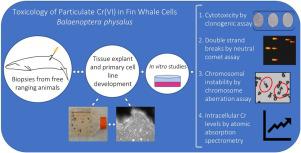Journal of Trace Elements in Medicine and Biology ( IF 3.6 ) Pub Date : 2020-05-26 , DOI: 10.1016/j.jtemb.2020.126562 Idoia Meaza 1 , Rachel M Speer 1 , Jennifer H Toyoda 1 , Haiyan Lu 1 , Sandra S Wise 1 , Tayler J Croom-Perez 1 , Abou El-Makarim Aboueissa 2 , John Pierce Wise 1

|
Background
Hexavalent chromium [Cr(VI)] is a human lung carcinogen and global marine pollutant. High Cr concentrations, resembling the ones observed in occupationally exposed workers, have been observed in fin whales (Balaenoptera physalus) in the Gulf of Maine. This outcome suggests Cr might be disrupting the health of fin whale populations. Indeed, Cr in acute (24 h) exposure does cause toxicity in fin whale cells. However, human cell culture data indicate prolonged exposures (120 h) induce a higher amount of toxicity compared to 24 h exposure due to an inhibition of homologous recombination repair. However, whether prolonged exposure causes similar outcomes in fin whale cells is unknown.
Objective
Due to the importance of assessing prolonged exposure toxicity, this study focuses on characterizing acute and prolonged exposure of Cr(VI) in male and female fin whale cells.
Methods
Cytotoxicity was measured by the clonogenic assay, also known as colony forming assay, which measures the ability of cells to proliferate and form colonies after the treatment. DNA double strand breaks were analyzed by neutral comet assay. Clastogenicity was measured using the chromosome aberration assay. Intracellular Cr levels were measured with Graphite Furnace Atomic Absorption Spectrometry (GFAAS) with Syngistix Software.
Results
In this study, we demonstrate that particulate Cr(VI) induces cytotoxicity and genotoxicity in a treatment-dependent manner after 24 h and 120 h exposures. Cytotoxicity levels were generally low with relative survival above 72%. DNA double strand break data and chromosome aberration data were elevated after a 24 h exposure, but decreased after a 120 h exposure. While cytotoxicity was similar after 24 h and 120 h exposures, less DNA double strand breaks and chromosomal instability occurred with prolonged exposure.
Conclusion
Particulate Cr(VI) is cytotoxic and genotoxic to fin whale cells after acute and prolonged exposures. The reduction of genotoxicity we have observed after 120 h exposure may be partly explained by lower intracellular Cr levels after 120 h. However, the decrease in intracellular levels is not reflected by a similar decrease in chromosome aberrations suggesting other mechanisms may be at play. Male fin whale cells appear to be more susceptible to the genotoxic effects of particulate Cr(VI) while female cells are less susceptible possibly due to increased cell death of damaged cells, but more work is needed to clarify if this outcome reflects a sex difference or interindividual variability. Overall, the study shows particulate Cr(VI) does induce toxicity at both acute and prolonged exposures in fin whales cells indicating Cr(VI) exposure is a health risk for this species.
中文翻译:

长期接触 Cr(VI) 颗粒对长须鲸细胞具有细胞毒性和基因毒性。
背景
六价铬[Cr(VI)]是一种人类肺癌致癌物和全球海洋污染物。在缅因湾的长须鲸( Balaenoptera physalus )中观察到高铬浓度,类似于在职业接触工人中观察到的浓度。这一结果表明铬可能会破坏长须鲸种群的健康。事实上,急性(24 小时)接触 Cr 确实会对长须鲸细胞产生毒性。然而,人类细胞培养数据表明,由于同源重组修复受到抑制,与 24 小时暴露相比,长时间暴露(120 小时)会产生更高的毒性。然而,长期暴露是否会导致长须鲸细胞出现类似的结果尚不清楚。
客观的
由于评估长期接触毒性的重要性,本研究重点关注雄性和雌性长须鲸细胞中急性和长期接触 Cr(VI) 的特征。
方法
通过克隆形成测定(也称为集落形成测定)测量细胞毒性,该测定测量细胞在处理后增殖和形成集落的能力。通过中性彗星试验分析DNA双链断裂。使用染色体畸变测定来测量染色体断裂性。使用石墨炉原子吸收光谱法 (GFAAS) 和 Syngistix 软件测量细胞内 Cr 水平。
结果
在这项研究中,我们证明颗粒 Cr(VI) 在暴露 24 小时和 120 小时后会以治疗依赖性方式诱导细胞毒性和遗传毒性。细胞毒性水平普遍较低,相对存活率高于 72%。 DNA双链断裂数据和染色体畸变数据在暴露24小时后升高,但在暴露120小时后下降。虽然暴露 24 小时和 120 小时后细胞毒性相似,但长时间暴露后,DNA 双链断裂和染色体不稳定的情况较少。
结论
急性和长期接触后,颗粒 Cr(VI) 对长须鲸细胞具有细胞毒性和基因毒性。我们在暴露 120 小时后观察到遗传毒性的降低,部分原因可能是 120 小时后细胞内 Cr 水平降低。然而,细胞内水平的下降并没有通过染色体畸变的类似下降反映出来,这表明可能有其他机制在起作用。雄性长须鲸细胞似乎更容易受到颗粒 Cr(VI) 的基因毒性影响,而雌性细胞则不太容易受到影响,可能是因为受损细胞的细胞死亡增加,但需要更多的工作来澄清这一结果是否反映了性别差异或个体间的变异性。总体而言,该研究表明,颗粒状 Cr(VI) 确实会在急性和长期暴露于长须鲸细胞时产生毒性,表明 Cr(VI) 暴露对该物种存在健康风险。











































 京公网安备 11010802027423号
京公网安备 11010802027423号